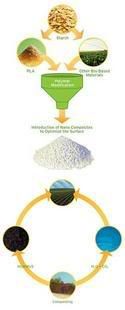Cereplast announces largest bioplastics facility in the world: 500 million pounds added
 Cereplast, Inc., a manufacturer of bio-based, sustainable plastics, announces the location of a new facility that will add half a billion pounds (226.8 million kg) a year to its bioplastic resin production capacity when the site is fully developed by early 2010. This will make it the world's largest manufacturing plant of renewable biopolymers which cut oil consumption. Operations will start at the site in January of 2008.
Cereplast, Inc., a manufacturer of bio-based, sustainable plastics, announces the location of a new facility that will add half a billion pounds (226.8 million kg) a year to its bioplastic resin production capacity when the site is fully developed by early 2010. This will make it the world's largest manufacturing plant of renewable biopolymers which cut oil consumption. Operations will start at the site in January of 2008.After a long search we decided to settle down in Indiana for this project, in the heart of the Midwest, where we have easy access to our raw materials allowing us to reduce the carbon footprint of our operations by reducing transportation lines. - Frederic Scheer, CEO and President of Cereplast.As the bioplastics sector grows, manufacturers find a need for flexible manufacturing solutions - a good location close to the required biomass source - that allows them to meet both the current and future demand. For Cereplast, the new Indiana facility allows the company to expand capacity immediately, and will enable it to keep pace with future growth. Rail service will help accommodate the enormous quantities of raw materials and finished goods that will move through the complex.
Cereplast says it has seen a positive response to the introduction of its 'Hybrid Resins'. It believes they will become mainstream plastics. This is due to the fact that the resins have nearly the same physical characteristics and price points as traditional polyolefins while plastics manufacturers can process the bio-based resins on conventional equipment. Because the bio-based resins contain less petroleum products, they are less susceptible to volatility in oil prices and this stability and transparency of future pricing has proven attractive to customers.
The resins can be processed at the same cycle time as traditional plastics, but require less energy in the production process by using significantly lower machine temperatures. All the company's biopolymers are treated with nanoparticles to impart significant structural and thermo-resistance characteristics.
Interest in the company’s newest product line, including Biopropolyene - the world’s first sustainable polypropylene - has been high, it says. Biopropylene replaces 50 percent or more of the petroleum-based content of conventional plastic resins with renewable resources such as cornstarch, tapioca (cassava) or other starches.
The company’s other product family, Cereplast Compostables resins, are nearly 100 percent bio-based, and are fully biodegradable and compostable meeting BPI (Biodegradable Products Institute) standards for compostability (ASTM 6400 D99 and ASTM 6868), and European Bioplastics standards (EN 13432). The products made from the bio-based resins break down in 60 to 180 days when placed in an industrial compost facility (schematic, click to enlarge). Composting is a natural process that allows greenhouse gas emissions – carbon dioxide – to sequestrate in soil instead of being released into the atmosphere:
 energy :: sustainability :: bioenergy :: biomass :: oil :: bioplastic :: biopolymer :: polylactic acid :: renewable :: carbon emissions :: biodegradable :: bioeconomy ::
energy :: sustainability :: bioenergy :: biomass :: oil :: bioplastic :: biopolymer :: polylactic acid :: renewable :: carbon emissions :: biodegradable :: bioeconomy :: Within weeks, Cereplast will begin operations at a new logistics processing center, allowing the company to better serve clients in the Midwest and the East Coast. To get the new facility up and runing, it will begin hiring managers, supervisors, extrusion operators, warehouse specialists and maintenance technicians in early 2008. When the site reaches full capacity in early 2010, it will employ up to 200 full-time staff and be the world’s largest bio-plastic resin production facility.
Production will start in an existing industrial building that is situated in Seymour, Indiana on more than 12 acres. Cereplast is planning to have additional buildings completed by early 2009. Rail service will help accommodate the enormous quantities of raw materials and finished goods that will move through the complex.
Cereplast's bio-based, sustainable plastics are used as substitutes for petroleum-based plastics in all major converting processes – such as injection molding, thermoforming, blow molding and extrusions – at a pricing structure that is competitive with petroleum-based plastics.
References:
Cereplast: Cereplast Expands Bio-Plastic Production with a New, Half-Billion Pound Capacity Indiana Facility - December 9, 2007.
 --------------
--------------
 According to the Instituto Brasileiro de Geografia e Estatística (IBGE), Brazil's production of sugarcane will increase from 514,1 million tonnes this season, to a record 561,8 million tonnes in the 2008/09 cyclus - an increase of 9.3%. New numbers are also out for the 2007 harvest in Brazil's main sugarcane growing region, the Central-South: a record 425 million tonnes compared to 372,7 million tonnes in 2006, or a 14% increase. The estimate was provided by Unica – the União da Indústria de Cana-de-Açúcar.
According to the Instituto Brasileiro de Geografia e Estatística (IBGE), Brazil's production of sugarcane will increase from 514,1 million tonnes this season, to a record 561,8 million tonnes in the 2008/09 cyclus - an increase of 9.3%. New numbers are also out for the 2007 harvest in Brazil's main sugarcane growing region, the Central-South: a record 425 million tonnes compared to 372,7 million tonnes in 2006, or a 14% increase. The estimate was provided by Unica – the União da Indústria de Cana-de-Açúcar.








1 Comments:
view us also at:
www.markatscotland.blogspot.com
We hope some of our articles and journals may be of interest to you.
Post a Comment
Links to this post:
Create a Link
<< Home